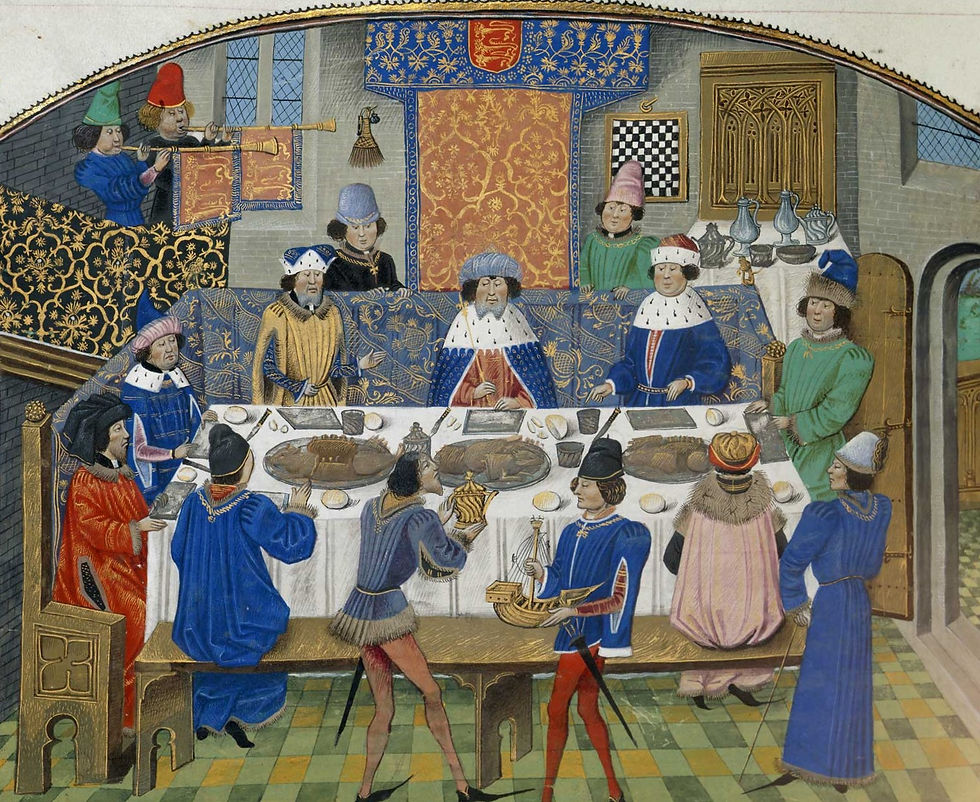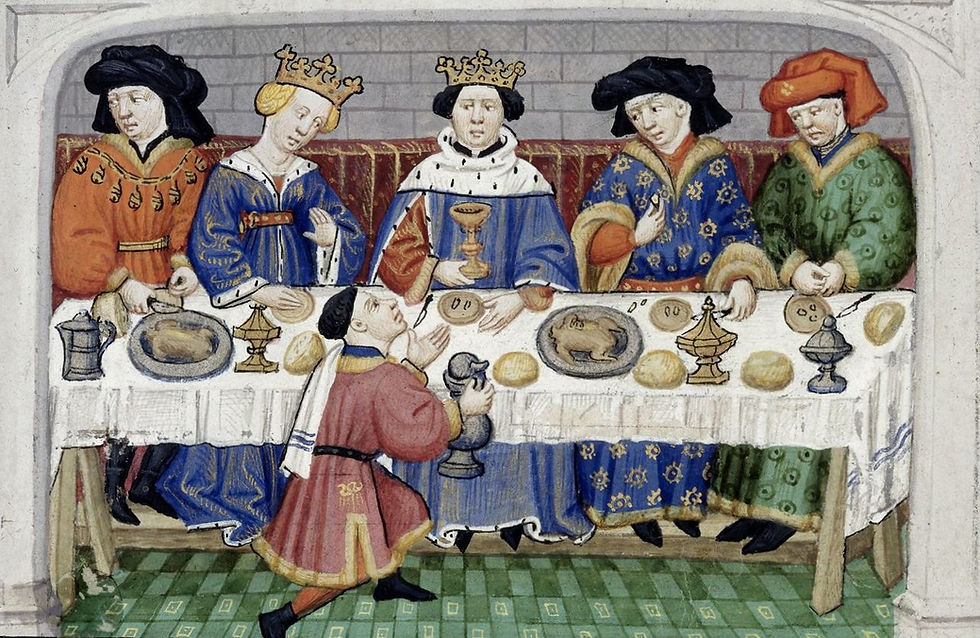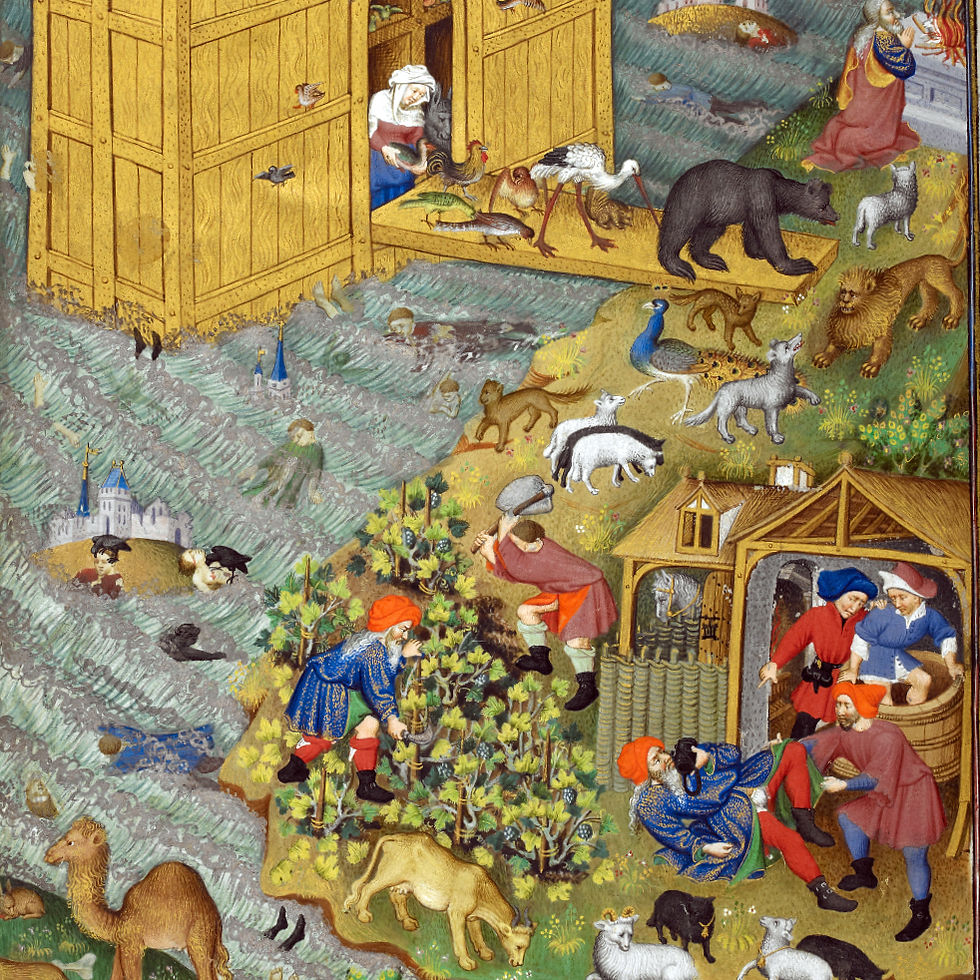In Illumination: From Divine to Sacred | From Drinking to Savoir-boire | From Vineyard to Port
From Drinking to Savoir-boire: Wine as an Everyday Companion

THE TEMPERATE AND THE INTEMPERATE
Facta et dicta memorabilia
Valerius Maximus
Bruges, 1475
The J. Paul Getty Museum, Los Angeles
Etiquette manuals were published and diffused from the thirteenth century. Such books taught readers to drink with the elbow held to the side of the body, and (for women) small sips only. A sharp distinction was made between the ill-mannered frequenters of noisy public houses, who spill their wine onto the table, and members of polite society, who knew and adhered to rules of good behavior. This miniature contrasts the two groups by showing rough, low-born plebeians rubbing shoulders with decorous members of the social elite!
During this period, Sundays were dull days of Church-imposed ‘rest’. Work was forbidden and intellectual distractions almost non-existent for the majority of the population. Cabarets offered a welcome break from the monotony, allowing patrons to socialise over cups of wine or beer. Taverns took the form of a large communal room furnished with tables and benches, sometimes with bedrooms to host the weary traveler (or to hide illicit encounters).
A well-educated drinker never picks up his glass by the cup or the stem, but rather by the base, between his fingers. A riddle even spells this out: “a wine cup held with five fingers”. From the 16th century onward, the stems of such drinking vessels were often so elaborately decorated that they were impossible to lift from here; as the stem of the glass had no practical function as a handle, it could be decorated extravagantly.
AN EVERYDAY COMPANION

A PEASANT MEAL Livre du roi Modus et de la Reine Ratio, 1401/50 - BnF, Paris

SNACK, GLASS OF WINE WITH FRUITS Heures de Charles d'Angoulême, ca. 1490 - BnF, Paris

AUGUST, HARVEST, SNACK FOOD Heures de Claude Gouffier, ca. 1545 - National Renaissance Museum, Ecouen, France

LEMON COLORED WINE COLOR Tacuinum Sanitatis, Vérone (?), 1380/99 - Oesterreichische Nationalbibl., Vienna, Austria

WHITE WINE AS FOODSTUFF Tacuinum Sanitatis, 14th century

BIRTH OF St JOHN THE BAPTIST Les Très Belles Heures de Notre Dame de Jean de Berry, ca. 1420 - Mus. civico d'arte, Turin, Italy / 6
> Click on the icons for a closer look at the artworks
"At once a drink, medical prescription, kitchen ingrediant and pharmaceutical product, wine is consumed in great quantities. At the time, water was not recommended, as it was often contaminated. In summer, pale, light wines were consumed; during the winter, strong wines; and in foggy weather, sweet white wines were considered more nourishing. A wine for each month… And it was not only drunk, but taken as a vapour, gargled, instilled, rubbed and applied to the body” (Source: Inrap). Wine was also appreciated for its supposed prophylactic properties.
6. As in Ghirlandaio’s painting on this topic, "mothers’ wine” is served to Elizabeth, the mother of St John the Baptist, in order to help her recovery after giving birth.
SOCIAL LIFE AND LIFE IN SOCIETY

DRINKING WHITE WINE AT TAVERN Tacuinum Sanitatis Österreichischen Nationalbibl., Vienna, Austria / 1

IN FRONT OF A TAVERN Tacuinum Sanitatis, Lombardy, Italy, 1395 - BnF, Paris / 2

DRINKING RED WINE AT TAVERN Tacuinum Sanitatis, 1445 - BnF, Paris / 3

TABLE SERVICE Histoire de Renaud de Montauban, 1470 - Arsenal Library, Paris

BANQUET IN AN INN WITH COURTESANS Facta et dicta memorabilia, ca. 1455 - BnF, Paris

BURGUNDIAN TABLE Valère Maxime, 1420/50 - Staatsbibliothek, Berlin

SWEAT LODGE, PLEASURES BETWEEN LOVERS Valère Maxime / 7

SWEAT LODGES, PUBLIC BATHHOUSE Facta et dicta memorabilia - BnF, Paris / 8

BATH, FOOD, AND DRINK IN THE BED-ROOM Manuscrit de Valère Maxime - BnF, Paris / 9

TRISTAN AND ISOLDE DRINKING THE LOVE POTION Lancelot du lac, de Gautier Map, 1470 - BnF, Paris / 10

ASSUERUS' FEAST Guiard des Moulins, 'Bible historiale' - BnF, Paris

ROYAL FEAST TO HONOR KING RICHARD II End of 15th century - British Library, London

THE WEDDING FEAST DE NOCES The Story of Olivier de Castille and Artus d'Algarbes - BnF, Paris

THE VERY RICH HOURS OF THE DUKE OF BERRY, JANUARY Frères de Limbourg, 1412/16 - Condé Museum, Chantilly, France

IOBAS OFFERING POISONED WINE TO THE FEASTING ALEXANDER Rouen, France, Follower of the Beauford Master - British Library, London
> Click on the icons for a closer look at the artworks
1 à 3. The Tacuinum Sanitatis is a medieval handbook mainly on health, based on the Taqwīm as siḥḥah ("Maintenance of Health"), an eleventh-century Arab medical treatise by Ibn Butlan of Baghdad. Aimed at a cultured lay audience, the text exists in several variant Latin versions, the manuscripts of which are characteristically profusely illustrated (300 pictures). Though describing in detail the beneficial and harmful properties of foods and plants, it is far more than a herbal. Listing its contents organically rather than alphabetically, it sets forth the essential elements for well-being: sufficient food and drink in moderation, fresh air, alternations of activity and rest, alternations of sleep and wakefulness, secretions and excretions of humours, and finally the effects of states of mind. Tacuinum Sanitatis says that illnesses result from imbalance of these elements. The Tacuinum was very popular in Western Europe in the Late Middle Ages.
7 à 9. Medieval public baths were places of pleasure: they were mixed, and visitors bathed naked. The baths themselves were large enough to fit several people at once. People would go there for washing, relaxing, shaving, massages…and perhaps more – prostitution was tolerated in such environments. Beds, for ‘relaxing’, were installed in the building. The moral degradation of such places worried the authorities; from the 15th century, little by little, rules were imposed: “One saw shouting, bedding down, leaping, and were so astonished that the neighbors tolerated it, the justices hid it, and the Earth allowed it.” Thus goes the witness account at the trial of Jeanne Saignant, the owner of one such bathhouse, sentenced to death by drowning in 1466 for constant breaches of the peace in her establishment (source: MHEU, Musée historique de l'environnement urbain).
10. With Tristan and Isolde, we move away from paid-for love. “The story of a pair of Breton lovers, Tristan and Isolde, was extraordinarily successful in the Middle Ages and, from the 12th century, gave birth to one of western culture’s founding myths. A tale of love and death, the story describes a pair of young, thwarted lovers who, faced with the impossibility of being together in life, find each other in death… Blanchefleur, the sister of Mark, king of Cornwall, marries the king of Lonnais in mainland Brittany. Upon hearing that her husband has died, she dies in childbirth. Her son, Tristan, is raised by Governal, and eventually moves to the court of King Mark. Unfortunately, the Cornwall of this tale is subject to an ancient custom: every year, a cohort of young people is sent to an Irish giant, the Morholt, as a tribute. Tristan defies and kills the giant; his injuries from the fight are treated by Isolde, daughter of the Irish king. King Mark, encouraged to take a wife by his barons, wishes to marry the young woman to whom belongs a strand of golden hair, brought to him by a swallow. Tristan returns to Ireland to look for this girl and kills a dragon which is threatening the country. Injured once more, he is again cared for by Isolde, the golden-haired woman he has been seeking. Tristan takes Isolde to his uncle’s court, but the pair mistakenly drink a love potion made of “herbal wine” (vin herbé) made by Isolde’s mother to ensure the success of her daughter’s marriage to King Mark. Under the influence of the potion, Tristan and Isolde fall madly in love. Whether lasting for three years (allowing Isolde to join Mark at the end of the period of enchantment), or permanent (there are many versions of this story), in any case Tristan and Isolde are destined to love each other profoundly but in secret.” (BnF, Paris)
DRUNKENNESS

DRUNKENNESS AND FIGHTING Tacuinum Sanitatis, ca. 1390 - BnF, Paris

WOMEN'S DRUNKENNESS Couvin, Les Trois Dames de Paris, ca. 1325 - Arsenal Library, Paris

THERAPEUTIC VOMITING Tacuinum Sanitatis, ca. 1445 - BnF, Paris

DRUNKS IN A TAVERN End of 14th century - British Library, London / 4

LEGEND OF THE DRUNKEN MONK UNDER ATTACK FROM THE DEVIL Les Miracles de Notre-Dame, les vies des Pères - The Hague / 5

THE SIN OF GLUTTONY Livre d'Heures, ca. 1475 - Poitiers, France
> Click on the icons for a closer look at the artworks
4. Even if the drunkard is subject to mockery, such lapses were considered harmless as long as they remained a simple error of judgement, or overestimation of one’s resistance to alcohol. However, drunkenness was considered a mortal sin if it was habitual – inveterate drinkers, those who spent all their time and money in taverns, subjected their families to ruin. Despite the social realities of the time, moralists could make themselves appear virtuous by condemning such establishments as ‘Hell’s antechamber’ and places of perdition. In the 15th century, Paris was home to over 200 taverns: “If you look at the stone house which stands on the marketplace and your eye is drawn to a rubicund face within, all will cry ‘this is an agreeable inn…’ […] The drinkers empty whole bottles […]. They stumble out of the tavern and fall into the grassy ditches…” (Carmina Burana).
5. Michel Pastoureau tells us that, prior to its demonization by the Christian authorities, who replaced it with the lion, the bear was considered king of the animals throughout Europe until the 12th century. This symbolic usurpation was part of the crackdown on Pagan practices associated with the bear, but also an attempt to wipe out an animal “which tried to rival Christ”. Numerous theologians took inspiration from St Augustine and Pliny the Elder in their efforts to discredit bears by portraying them as evil. Thus linked to the Devil, the bear was soon considered his favorite animal or one of his many corporeal forms. In Christian iconography, the Devil is often shown as having the paws, muzzle and fur of a bear, and was said to take the form of this animal in the dreams of certain saints, kings and monks. The thick coat and brown coloring of the bear were to become a sign of demonic bestiality and the animal soon loaded with cardinal sins such as intemperance, deception, lust, anger, envy and sloth.
SAVOIR-BOIRE

NEW WINE TASTING Tacuinum Sanitatis, 1390 - BnF, Paris

OLD AROMATIC WINES FROM RHINE VALLEY, DEGUSTATION Tacuinum Sanitatis,1445 - BnF, Paris / 2

TASTING AT MEDIEVAL TIMES Heures de la reine Yolande ca. 1460 - Bibl. Méjanes Library, Aix-en-Provence, France
> Click on the icons for a closer look at the artworks
2. "The tavern is the focal point of Medieval sociability. Here are contracts are agreed, commercial exchanges agreed, news spread. People drink a lot of wine in the Middle Ages. If white wine is thought better for older people, red is not forbidden to young people and children; physicians do, however, bar them from drinking older, fruity wines (more alcoholic), which are ‘harmful to the senses and memory of children.’” (Source: BnF).
GALLERIES IN ILLUMINATION
> Wine and Painting > In Illumination > From Drinking to Savoir-boire




